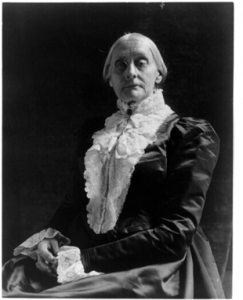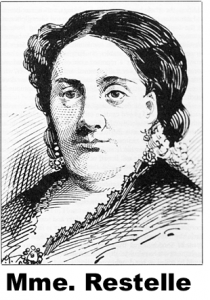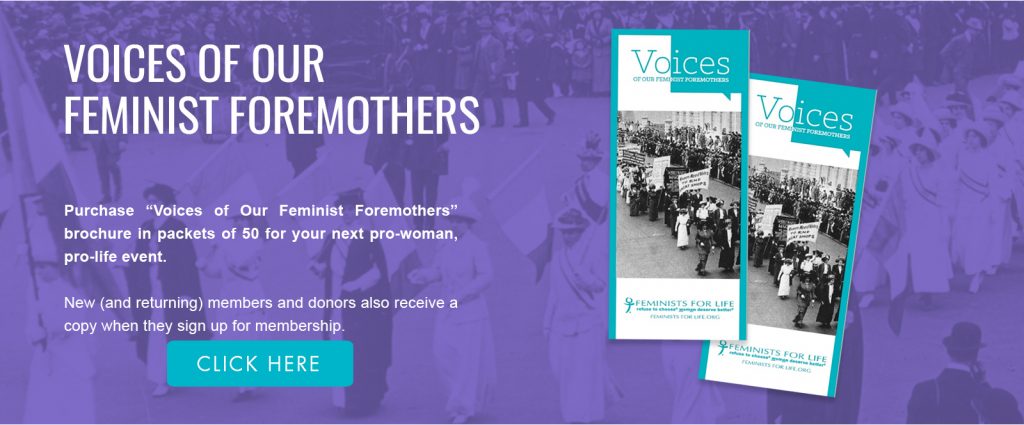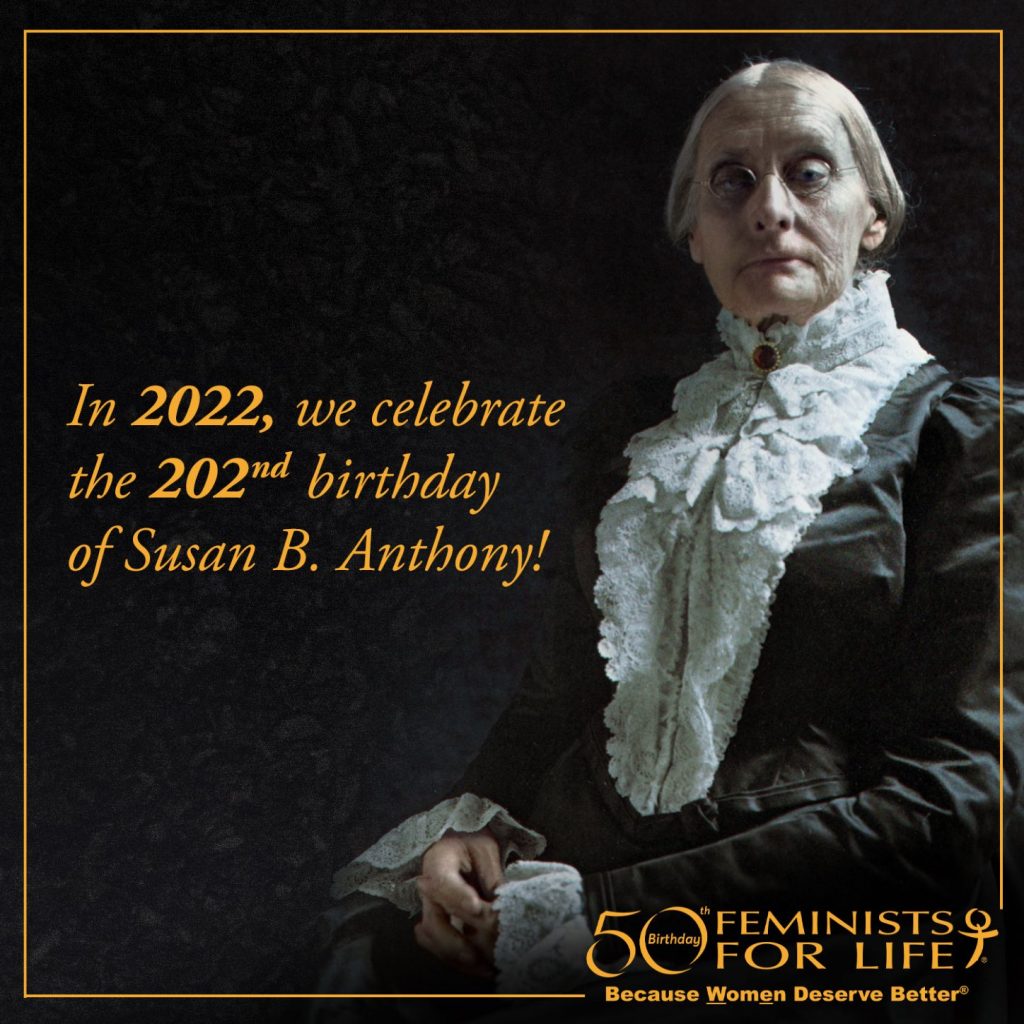 As Feminists for Life has gained more attention in the media, FFL’s pro-life feminist legacy has met with increasing suspicion and skepticism, with some accusing FFL of hijacking America’s leading suffragist, Susan B. Anthony.
As Feminists for Life has gained more attention in the media, FFL’s pro-life feminist legacy has met with increasing suspicion and skepticism, with some accusing FFL of hijacking America’s leading suffragist, Susan B. Anthony.
“There’s absolutely nothing in anything that she ever said or did that would indicate she was anti-abortion,” Gloria Feldt, former head of Planned Parenthood Federation of America, told Women’s eNews.
“I don’t know what [Anthony’s] position on abortion is,” Lynn Sherr, an Anthony biographer and ABC 20/20 correspondent, told Women’s eNews, “and for [pro-life feminists] to pretend they do is simply flat-out wrong…. I looked desperately for some kind of evidence one way or the other as to what her position was, and it just wasn’t there.”1
Abortion was not an issue to which Anthony devoted much time. But the historical evidence that does exist points to her opposition to abortion.
“Her stance on abortion was one integral expression of her commitment to undo gender oppression, just like her sheltering of a woman and child fleeing domestic violence,” notes pro-life feminist historian Mary Krane Derr. “Susan B. Anthony identified socially entrenched patterns of male sexual and reproductive violence (often fueled by alcohol abuse; hence many early feminists’ concern, including hers, with temperance) as the root cause of abortion and many other miseries of women.”
However, Derr cautions, “While it’s not outrageous to speculate that today Anthony would vigorously champion women’s right to make nonviolent choices regarding their bodies and lives, no one can ever know with absolute certainty what any person from the past would say and do now.”
What did Susan B. Anthony say about abortion? How do modern pro-life feminists continue her legacy?
Her Friends and Colleagues Denounced Abortion
“Without known exception,” FFL President Serrin Foster says in The Feminist Case Against Abortion, “the early feminists condemned abortion in the strongest terms.”
Early 18th- and 19th-century suffragist writings regularly referred to abortion as “ante-natal murder,” “child murder,” “ante-natal infanticide,” or “infanticide,” as Derr points out in ProLife Feminism Yesterday and Today.2 These early feminists regarded abortion as violence against women and their children and attributed its practice to the denial of their rights and a dearth of nonviolent choices for women.
While early feminists were indeed concerned about abortion’s physical and psychological dangers to women, as advocates of abortion point out, they also opposed abortion itself — as their use of the term “child murder” implies.
Sarah Norton, who challenged Cornell University to admit women, for example, wrote that she looked forward to a day “when the right of the unborn to be born will not be denied or interfered with.”3
Like Feminists for Life today, the early feminists saw abortion as a symptom of, not a solution to, the struggles women face. And the early feminists, like FFL, sought to eradicate abortion by addressing its root causes.
Susan B. Anthony and Abortion: In Her Own Words
The most important evidence regarding Anthony’s own stance on abortion are those writings which may be attributed to her with certainty. Her comments relating to abortion are few, but considered in the broader context of early feminist writings, it is reasonable to conclude that Anthony was truly both pro-woman and pro-life.
The earliest relevant comment appears in a letter Anthony wrote to Antoinette Brown Blackwell on September 4, 1858. A schoolteacher, doting aunt, and willing babysitter, Anthony loved children, but she expressed frustration that her friends’ family responsibilities limited their availability for suffrage activities. When Elizabeth Cady Stanton was expecting her seventh child, Anthony wrote:
I only scold now that for a moment’s pleasure to herself or her husband, [Stanton] should thus increase the load of cares under which she already groans — but there is no remedy now.…4
Once pregnant, the nonviolent choice was clear: Stanton would give birth — to a son, Robert, in March 1859.5
The second comment, much more explicit, appears in Anthony’s famous speech, “Social Purity,” delivered on March 14, 1875. Here, abortion is listed with infanticide and other murders among the negative consequences of the “evils” perpetrated by men:
The prosecutions on our courts for breach of promise, divorce, adultery, bigamy, seduction, rape; the newspaper reports every day of every year of scandals and outrages, of wife murders and paramour shooting, of abortions and infanticides, are perpetual reminders of men’s incapacity to cope successfully with this monster evil of society.6
This speech clearly presents abortion as a symptom of the problems faced by women, especially when subjected “to the tyranny of men’s appetites and passions.” Anthony argues that it is not sufficient to address these effects; “the cause must be removed… the taproot must be severed” by enfranchising women, acknowledging their rights in family and society, and empowering them to make nonviolent choices.
A third piece of evidence comes from a pair of entries in Anthony’s diary, written while she was visiting her brother Daniel during a speaking tour in 1876. Daniel’s wife was apparently suffering the effects of an abortion:
[March 4] Sister Annie in bed — been sick for a month — tampering with herself — and was freed this A.M. what ignorance & lack of self-government the world is filled with.
[March 7] Sister Annie better — but looks very slim — she will rue the day she forces nature —7
The latter entry is reminiscent of one that appeared in Mary Wollstonecraft’s A Vindication of the Rights of Woman, which Anthony serialized in her own newspaper, The Revolution.8 Regarding women who “either destroy the embryo in the womb, or cast it off when born,” Wollstonecraft wrote: “Nature in everything demands respect, and those who violate her laws seldom violate them with impunity.”9
A final relevant comment is recorded by fellow suffragist Frances Willard. When complimented by a man, “you, of all women I have met, ought to have been a wife and mother,” Anthony replied:
I thank you, sir… but sweeter even than to have had the joy of caring for children of my own has it been to me to help bring about a better state of things for mothers generally, so that their unborn little ones could not be willed away from them.10
In Anthony’s day, if a father willed custody of his children to someone other than his wife and then died while she was pregnant, the mother would be denied custody of her child as soon as the child was born. Anthony’s statement shows concern for the lives and well-being of both the mother and the yet unborn child.
Anthony’s Newspaper Opposed Abortion
 Among her many forms of activism, Susan B. Anthony was the proprietor and business manager of the early feminist newspaper, The Revolution. From the very beginning, The Revolution had a known policy that “no quack or immoral advertisements [for patent medicines] will be admitted,” though these ads were a large source of revenue for periodicals of the time.11
Among her many forms of activism, Susan B. Anthony was the proprietor and business manager of the early feminist newspaper, The Revolution. From the very beginning, The Revolution had a known policy that “no quack or immoral advertisements [for patent medicines] will be admitted,” though these ads were a large source of revenue for periodicals of the time.11
The women and men who produced the paper were not opposed to alternative and self-help medicine, nor advertisements for doctors, but refused such advertisements because “Restellism [a period term for abortion] has long found in these broths of Beelzebub, its securest hiding place.”12
This policy undermines the belief held by some advocates of abortion that the early feminists’ opposition to abortion was due to the dangers of the procedure performed late in pregnancy. In fact, the patent medicines that The Revolution refused to advertise were often abortifacients designed to induce early miscarriage.
Parker Pillsbury, co-editor with Elizabeth Cady Stanton, explained The Revolution’s advertising policy in the context of criticizing less principled publishers. In an article titled “Quack Medicines,” he wrote:
Quack advertisements may lie never so fearfully about the stuffs offered for sale; but they speak truly of those who make and sell them, and not less truly of their accomplices of the press that for gain and greed, will advertise and puff their foul preparations. When conductors of public journals are so poor in pocket and principle as to lend themselves to so foul a work, they should be read always between their lines. They and their advertising patrons in such business should be read out of their occupation by a wholesome regard for the moral and material health of the community…. Sword, pestilence and famine combined, are to be preferred to such a presence….
Quack Medicine venders, however rich, proud, and pretentious, Foeticides and Infanticides, should be classed together and regarded with shuddering horror by the whole human race….
Let us learn to read authors between their lines, and to judge of newspapers largely by their advertisements. Thus we shall get an autobiography of all the authors, and learn the true quality and character of our newspaper press.13
The Revolution ad policy could only be implemented with Anthony’s approval. As the paper’s masthead shows, her responsibilities included selling advertising space, and the policy remained in place despite the newspaper’s financial problems. When the newspaper went bankrupt in 1870, Anthony assumed responsibility for the $10,000 debt, which she paid off through “terrible struggle” over a period of seven years.14
Another possible piece of evidence regarding Anthony’s stance on abortion may be found in a Revolution article “Marriage & Maternity,” which is simply signed “A.”15 The best known passage says:
Guilty? Yes, no matter what the motive, love of ease, or a desire to save from suffering the unborn innocent, the woman is awfully guilty who commits the deed. It will burden her conscience in life, it will burden her soul in death; but oh! thrice guilty is he who, for selfish gratification… drove her to the desperation which impelled her to the crime.
As advocates of abortion have correctly pointed out, the article does not favor a law punishing abortion. But it is clearly not an endorsement of abortion:
Much as I deplore the horrible crime of child-murder, earnestly as I desire its suppression, I cannot believe… that such a law would have the desired effect. It would only be mowing off the top of the noxious weed, while the root remains.
We want prevention, not merely punishment. We must reach the root of the evil, and destroy it.
The article argues that a law, in that time and place, would only be used to punish the wrong people: “All the articles on this subject…. Denounce women alone as guilty, and never include man in any plans proposed for the remedy of the evil…. If man takes [woman’s] individuality [by subjecting her to his demands] he must also take her responsibility. Let him suffer.”
Was this article, which appeared in Susan B. Anthony’s newspaper, written by Anthony? Ann Gordon, editor of The Selected Papers of Elizabeth Cady Stanton and Susan B. Anthony, told Women’s eNews that Anthony did not write the article, and Lynn Sherr concurred. But Mary Krane Derr, co-editor of ProLife Feminism Yesterday and Today, has argued that the article may indeed be Anthony’s.
At the time, members of The Revolution staff frequently signed articles with their initials: Elizabeth Cady Stanton as “E.C.S.,” Paulina Wright Davis as “P.W.D.,” and Susan B. Anthony as “S.B.A.” Anthony was also known in the writings of others as “Miss A.” Sherr’s reported claim that “Anthony didn’t sign her pieces ‘A.’”16 presumes a conclusion that needs to be proven.
The “Marriage & Maternity” article bears striking resemblance to Anthony’s “Social Purity” speech in language, concepts, and themes. Laws, according to both, were wrongly used to punish people whose actions were impelled by desperate circumstances — people who could not support themselves financially, vote, or even, in many cases, testify in court. Both pieces regard abortion as a social ill, a consequence of wrongs perpetrated by men against women that is best eradicated by addressing its root causes and expanding nonviolent choices. Both uphold the right of women to refuse the sexual demands of their husbands as a necessary part of the solution. Despite their different subjects and modes of communication, the similarities are remarkable.
Nevertheless, Feminists for Life is cautious about the attribution of “Marriage & Maternity.” In FFL materials, it is simply said to have appeared in Susan B. Anthony’s publication, The Revolution.
“If one reads the actual text of The Revolution, and every mention of abortion in Anthony’s newspaper opposed abortion, then how can anyone come to the conclusion that she was in favor of it?” asks Serrin Foster.
The Logical Conclusion: Anthony Was Pro-Woman and Pro-Life
Susan B. Anthony’s words and actions, in the broader context of early American feminism, point to the logical conclusion that Anthony was truly pro-woman and pro-life.
Feminists for Life, just as Anthony and our other feminist foremothers, recognizes that abortion is a reflection that our society has failed to meet the needs of women. In response, we are dedicated to systematically eliminating the root causes that drive women to abortion — primarily lack of practical resources and support — through holistic, woman-centered solutions. We promote the resources women want and need to make nonviolent choices, and our own efforts are shaped by the core feminist values of justice, nondiscrimination, and nonviolence.
FFL’s mission increasingly resonates with those who find abortion to be an unacceptable “solution” to the difficulties that pregnant women and parents face.
“It is not enough to say ‘no’ to abortion. We say ‘yes’ to life,” says Serrin Foster. “While we would be pro-life feminists whether or not Susan B. Anthony and the other early American feminists opposed abortion, we are proud to continue their legacy. By giving birth to new solutions, Feminists for Life builds on the foundation they created. We are working to realize their unfulfilled vision for the world.”
By Cat Clark
The author is grateful for the research and assistance provided by Mary Krane Derr, co-editor of ProLife Feminism Yesterday and Today: Expanded Second Edition.
1 Quoted in “Susan B. Anthony’s Abortion Position Spurs Scuffle” by Allison Stevens, Women’s eNews (October 6, 2006), http:// www.womensenews.org/article.cfm?aid=2915.
2 ProLife Feminism Yesterday and Today: Expanded Second Edition, Mary Krane Derr, Rachel MacNair, and Linda Naranjo-Huebl, editors (Xlibris; 2005).
3 Woodhull’s and Claflin’s Weekly, November 19, 1870.
4 Derr et al., 43, emphasis added. The passage also appears in Lynn Sherr’s Failure Is Impossible: Susan B. Anthony in Her Own Words (New York: Random House; 1995), 4.
5 The author called the Women’s Rights National Park in Seneca Falls, New York, to confirm Robert Livingston Stanton’s birth on 14 March 1859.
6 “Social Purity,” http://www.pbs.org/stantonanthony/resources/index.html?body=social_purity.html.
7 The Selected Papers of Elizabeth Cady Stanton and Susan B. Anthony , vol. III, Ann Gordon, ed. (Brunswick, NJ: Rutgers University Press; 2003), 213-214. The volume’s editor notes that “tampering” is “inducing an abortion.”
8 Anthony’s copy of Wollstonecraft’s classic resides in the Library of Congress’ Susan B. Anthony Collection (http://memory.loc.gov/ammem/awhhtml/awrbc4/).
9 Mary Wollstonecraft, A Vindication of the Rights of Woman (London: Penguin Books; 1985), 249.
10 Derr et al., 43, quoting from Frances E. Willard’s Glimpses of Fifty Years:The Autobiography of an American Woman.
11 “What the Press Says of Us,” The Revolution, February 5, 1868. See also James C. Mohr, Abortion in America (New York: Oxford University Press; 1978), 47ff.
12 “Important Movement,” The Revolution, April 8, 1869.
13 The Revolution, March 26, 1868.
14 Sherr, 200-201.
15 The Revolution, July 8, 1869. A significant excerpt appears in ProLife Feminism Yesterday and Today: Expanded Second Edition, 44-47.
16 Stevens.
Buy your copy of our 2020 calendar today. It is on sale!







